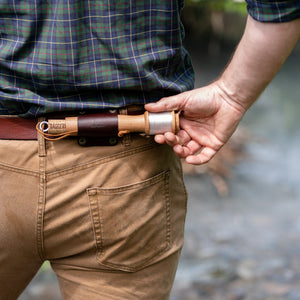Beyond the Basics Part 1: Spin Fishing with your Daggerfish

Adam Nelson
Founder of The Daggerfish Gear Co.
When I created the Daggerfish, I was looking for a way to make fishing a part of the other things I’d been doing outdoors, like backpacking, camping, canoeing, and biking.
And it’s great as a backpacking fishing rod - it’s easy to pack, can carry a nice variety of tackle inside the reel, and its small size lets us more easily reach secluded fishing spots that other anglers can’t access.
But fishing with the Daggerfish isn’t without its challenges. Fortunately, it’s still possible (and fun) to use the Daggerfish for spin fishing or fly fishing, with just a slight adjustment to our tackle and technique. To find some of the best approaches, I talked with my brother Evan, who’s been fishing for over twenty-five years. Here’s what he recommends:
Target the right size fish
Without a rod and with a lighter test line, we’re not going after monsters.
Instead, we’ll be targeting smaller trout, bass, and panfish, up to 2-4 lbs at their largest. Still plenty big for a great day on the water or a backcountry meal, but small enough to be manageable with the Daggerfish.
Choose bait that these fish can attack: look for spin casting lures roughly 2 inches and less in size (unless you’re going for largemouth bass, where lure size is less important). As a bonus, lures of this size, especially soft plastics, will often fit inside the tackle storage areas of the Daggerfish. And as Evan told me, “Remember, smaller bait doesn’t necessarily mean smaller fish - just look at what you can catch with a little fly.”
If you do hook into a big fish, you’ll have to be patient, and move to the fish to land it. Try to get downstream of the fish, so that it’s fighting you and the current at the same time, and slowly work the fish in. Landing a big fish is definitely a challenge, but going mano-a-mano without a rod is a real delight.
Rig for weedless when possible
Since we don’t have the reach of a rod, and are commonly fishing from shore, the last few feet of a retrieve can often pull the lure through aquatic vegetation.
Using a hook with a weed guard or a Texas or Carolina rig to more easily navigate vegetation, rocks, and trees will improve your retrieve and keep you from having to regularly clean off your lure.
Maximize time in the water per cast
Without the mechanical gearing of a spin casting reel, line retrieve with Daggerfish is slower and fishing a spinner or crankbait can present an extra challenge.
With that in mind, choose lures that don’t need a fast retrieve. Live bait and a bobber is an easy choice, and using a slip bobber or weighted bobber will make long-distance casting easier.
For artificials, soft plastic or hair jigs are a great choice, since we can work them in more slowly, making it easier to keep up with reeling. Evan recommends this as a great method for going after crappie.
“Fishing a small jig under a weighted bobber is a very popular way to catch panfish, especially crappie. The jig needs very little action and crappie like a subtle presentation anyway, and the bobber suspends the jig at the right depth keeping it from getting hung up.”
If you’re looking to use a hard bait or a stickbait, focus on topwater lures to start.
“You’ll want something that floats that you can work slowly along the top of the water,” Evan recommends. “Try a small popper, torpedo, or hollow body lure and use a walk-the-dog technique. You’ll actually be blending spin fishing and fly fishing techniques, using a spin fishing lure but manipulating the line, not the rod, to create action in the water.
“It’ll take patience,” he says, “but it’ll be rewarded when a big bass comes to swallow your lure off of the surface.”
When All Else Fails, Move
Use the portability of your small fishing pole to your advantage. If the fish aren’t responding or have been spooked, move to a new area, or change your position to approach more stealthily.
Since you don’t have a rod to worry about with your Daggerfish, you can move through thicker brush with greater ease, and fish the secluded spots where others dare not tread.
Experiment and Share
By selecting the right tackle for the job and making a couple basic adjustments to our technique, we can effectively go spin fishing for trout, bass, panfish, and other species. By re-spooling the Daggerfish with heavier line, we can even go after species like carp.
But these are just starting points - experiment in your local waters and with your favorite tackle, find what works for you, and share with us what you’ve discovered.
If you’d like to contribute and help other members of our backcountry community find the calm and confidence of simple fishing, please share your Daggerfish spin fishing tips with us on Facebook and Instagram, or email us with your ideas. We’ll collect the best suggestions and publish them in a future article.



















